
11 minute read
Into the woods and out to the sea
Nuuksio National Park in Espoo.
Text by Anna Eloaho
Advertisement

Into the woods and out to the sea W ith its 1,5 million inhabitants, the Helsinki Metropolitan area is the most densely habited part of Finland. One might think that in order to escape the urban hustle and bustle for pure nature one should travel rather far from the capital region. We let you in on a secret: there is proper Finnish forest within walking distance from the city centre, to be reached in just 15 minutes. In fact, there is no other capital region of over million inhabitants in the world with so much surrounding nature. The Central Park of Helsinki makes it possible to reach a forest by foot from anywhere from the city centre. Traversing Helsinki from south to north, the Central Park is the green gateway for the commuters as well as an easily reachable outdoor haven for those who enjoy the smell of green forest and birdsong. Founded in 1914, the Central Park offers opportunities for outdoor sports and recreation throughout the year. Central Park begins near the Helsinki Opera House at the Töölönlahti Bay, in the middle of the city.
Central Park ends in the untouched primeval forest of Haltiala by the river Vantaa on the northern border of Helsinki. Other nature protection areas in the northern part of the park include Pitkäkoski deciduous forest, Niskala arboretum and Ruutinkoski deciduous forest. The green zones of the Metropolitan area form a unique Green Belt, extending from the Sipoonkorpi area to the peninsula of Porkkala. The Green Belt consists of the archipelago, the coastline, the rivers, the forests, the bogs and the cultural landscapes of the Metropolitan area. The numerous nature conservation areas as well as the more recreational areas all form a pathway and a natural network allowing animals and plant species to transfer from one area to another. The widest forest areas, such as the Nuuksio and Sipoonkorpi National Parks in Espoo and Sipoo and Petikko in Vantaa are situated outside Kehä 3 (Ring 3) road.
Petikko, Sipoonkorpi and Nuuksio National Park all have walking trails to offer. In Nuuksio, for example, it is possible to choose between several trails of different lengths. The shortest one, the Maahisenkierros trail (1.9 kilometres) is accessible for wheelchairs and baby buggies. There are dozens of recreational forests, walking routes, arboretums and woodland areas within easy reach in the Metropolitan area. By public transportation one can easily reach woodland gems such as the oak forest of Tammisto in Vantaa, the Viikki arboretum at Vanhankaupunginlahti, Uutela nature trail in Vuosaari in eastern Helsinki and Haaga Rhododendron park in western Helsinki. Longer urban walking and hiking routes include the Espoo Rantaraitti by the seaside. The Metropolitan area has plenty of options for bikers, too. Among them are the various themed bike routes such as “ the Central Park 100 years” and “the Olympic games of Helsinki in 1952”.
A great choice for a nature enthusiast on a rainy day is Haltia Nature Centre, close to the Nuuksio National Park in Espoo. Along with exhibitions, shop and restaurant it offers more detailed information about the Metropolitan nature network Green Belt. Other interesting options include the Botanic Garden in Kaisaniemi as well as the Botanical Garden (Talvipuutarha) at Töölö Bay.
Finland is known as the “Land of the thousand lakes”. It’s rather an understatement, as the total number of lakes in Finland is 188,000. The amount of islands is rather impressive too, as there have been counted to be nearly 180,000 islands in all of Finland. Most of these islands are situated inland amid the thousand lakes, but a great number of islands are located on the coast. The four principal archipelagos of Finland include the Kotka archipelago in the Gulf of Finland, the Archipelago Sea in the Southwest Finland and Åland, the archipelago in the Gulf of Botnia and the Helsinki archipelago.
The most popular attraction in the Metropolitan archipelago is Suomenlinna Sea Fortress. The ferry (part of the Helsinki region public transportation HSL) from the Helsinki Market Square (Kauppatori) takes you there in just 20 minutes. The fortress with its bastions and cannons was built in the latter part of the 1700’s under the Swedish reign. Suomenlinna Sea Fortress has been a UNESCO World Heritage site since 1991.
Kauppatori harbour offers plenty of other options as well, as there are boats leaving for several other island destinations. Lonna, a former military island is a tiny island just outside Suomenlinna. Another former military island Vallisaari was opened for public in 2016, having been in military use for over 400 years. This summer Vallisaari is also the site of the very first Helsinki Biennale, introducing 40 Finnish and international artists and their site-specific work. From Vallisaari it is possible to walk to yet another island, Kuninkaansaari, as the two islands are connected by a narrow land bridge. Pihlajasaari is one of the summer classics among the people of Helsinki and as it is rather large island (two in fact!), it’s easy to find a peaceful spot for sun bathing there. Ferries for Pihlajasaari leave from Kaivopuisto Sea Harbour and from Ruoholahti. Another Helsinki classic, Mustikkamaa is an island, too, but can be reached by foot or bike via Isoisänsilta (“the Grandad’s Bridge”) from Kalasatama. Through Mustikkamaa island one can even reach Korkeasaari island, the site of Helsinki Zoo by foot. The boats for Helsinki Zoo leave from Kauppatori harbour and from Hakaniemi.
The utmost classic of the island destinations in Helsinki is Seurasaari with its open-air museum. As Seurasaari is located just a few kilometres from the heart of Helsinki, the HSL bus number 24 takes you to the bridge in just few minutes. The displayed cottages and farmsteads have been relocated from all around Finland.
There are 165 islands in Espoo alone. Along the Archipelago Route (Saaristoreitti) one can see many of them and also visit several. In Iso Vasikkasaaari for example one can spend an entire day as both a summer restaurant and outdoor cooking facilities are provided. Saaristoreitti boats leave from Otaniemi and Kivenlahti harbours.
For those who fancy to go even further to the sea can step into a boat at Kauppatori (or Aurinkolahti in Vuosaari or Kalkkiranta in Sipoo) and head for the Söderskär lighthouse in the Porvoo archipelago. s

MORE INFORMATION • nationalparks.fi • hel.fi/helsinki/en/culture/recreation • citynature.eu/en/helsinki • espoo.fi/en-US/Housing_and_environment/ Environment_and_nature • vantaa.fi/leisure/nature_and_outdoor_recreation
The King's Gate at Suomenlinna Sea Fortress.

METROPOLITAN TIMES COLUMN

Hitched to hotels
Written by Tomm i Kinnunen Translated by Anna Eloaho
Spending nights in hotels was not something I got used to as a child. My parents worked as photographers in a small district in northern Finland and to accommodate a family of seven in a hotel would have cost far too much. Hence, on the rare vacations were got used to spending nights on makeshift beds on the floors of friends and relatives. And what I had learned as a child, I carried on as a student. On occasional trips to other towns, I would crash on the spare mattresses of my local friends. We would laugh, talk and make the world a better place until four in the morning and then empty the refrigerator for breakfast.
Therefore I was truly seduced by hotels only as an adult. They whisked me away from a day-to-day life, into a totally different word where daily routines, such as cleaning, making breakfast and changing the linen would be done for me by someone else, all I had to do was to enter. At home I would fantasize how my messy one-room flat would one day become clear and contemplated as a hotel room.
A little luxury to balance a lot of every day life. That was the kind of hotel relation I yearned for. To be able to take a weekend away, see a play in a strange city after a working week. To be able to stay in an elegantly decorated room and to enjoy the difficulty of multiple choice at the sumptuous breakfast buffet. We all recognize the tingling joy of entering a new room for the first time. One is compelled to draw the curtains and check the view, open the door and inspect the bathroom. It’s almost annoying to open the suitcase and start unpacking the mundanities of one’s normal life into that beautiful utopia.
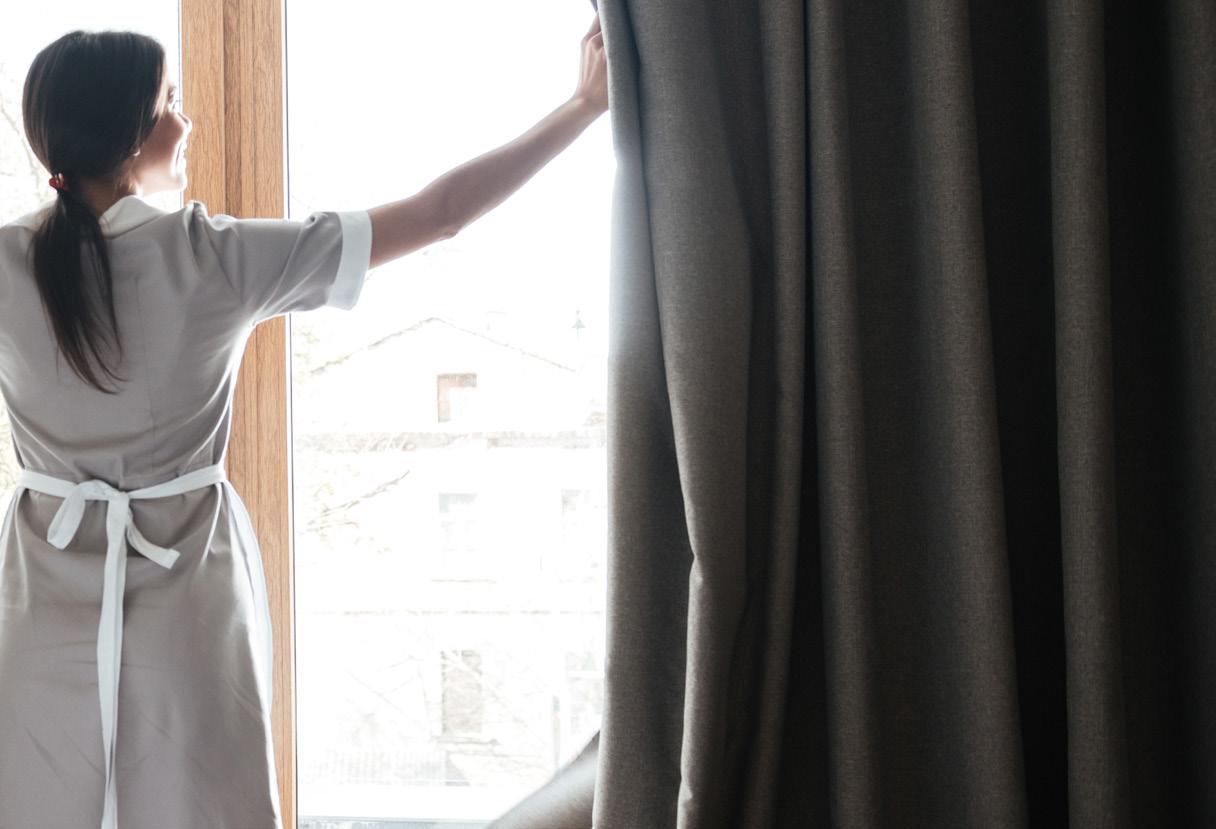
Then our relationship changed. My work as a novelist started to take me to hotels more often that I thought was even necessary. Our relationship turned habitual. There always seemed to be the same rainy street-view behind the curtains and the same indifferent beds and tables in the room. The only cause for a slight excitement was whether there would be a tub or a shower in the bathroom.
Suddenly we were no longer lovebirds but in a steady relationship. When previously I had wanted a hotel to be the unordinary non-home, nowadays when a hotel room functions as my home base during the author visits, I quite unexpectedly yearn for likeness of home from it. Instead of a hotel in the luring pulse of the city centre, I prefer a quiet location. I, too, keep to my room, having no interest to go nightclubbing. Instead of the abundant breakfast buffet a middle-aged man appreciates the light vegetarian choices. And rather than room service he prefers the possibility to iron his costume before making his public appearance. What will the next step be? Are we to become an old married couple, knowing each other’s needs without words. There will be a thin pillow and a thick duvet for my aching bones waiting for me on my arrival and I will know my way around the building and into the breakfast room without instructions. Perhaps later on we will grunt on my grow-up daughter’s relation to hotels: her stories about the exciting weekend trips, spectacular lounges and beautiful decorations. Who knows.
At the moment, however, she is just six years old and has very little experience in hotels. And although the 800-kilometre drive to see grandmother requires us to stop overnight, we have a habit of spending the night in the guestrooms of the relatives. s
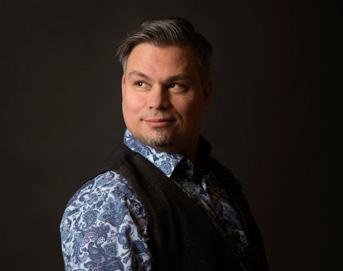
Tommi Kinnunen (b.1973) is an author and a school teacher of Finnish literature. He was born in Kuusamo, north-east Finland and currently lives in Turku. His debut novel, Where Four Roads Meet (Neljän tien risteys, 2014) was shortlisted for the Finlandia Prize for Fiction and awarded with several literature awards. Where Four Roads Meet has been adapted to theatre as well. Kinnunen’s second novel, the Light Behind the Eyes (Lopotti, 2016) was also shortlisted for Finlandia Prize. His third, The Glass River (Pintti, 2018) was awarded with the Bothnia Literary Prize. Kinnunen’s works have been translated into 20 languages. His fourth novel will be published in autumn 2020.
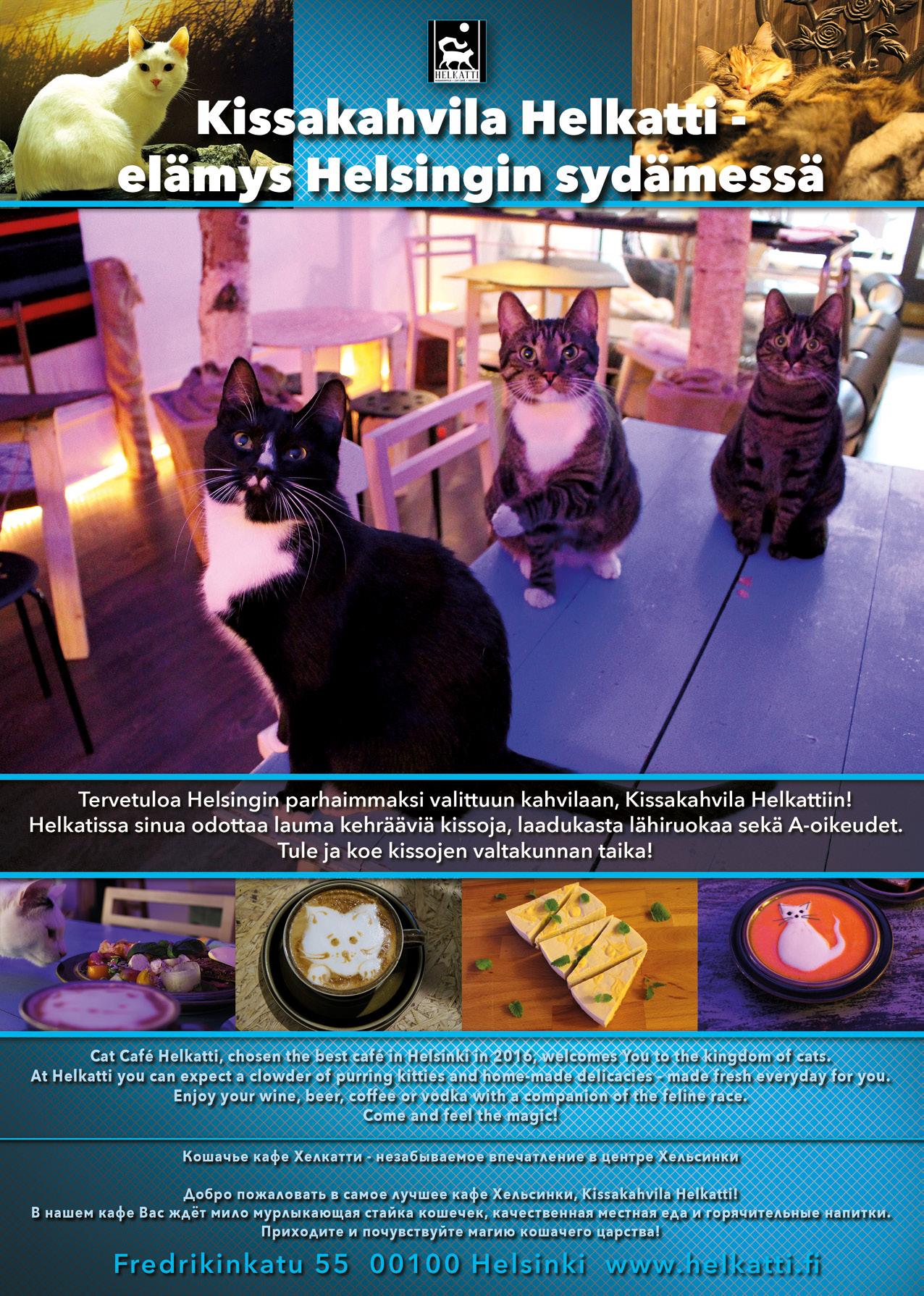
BREWERY DISTILLERY BAR
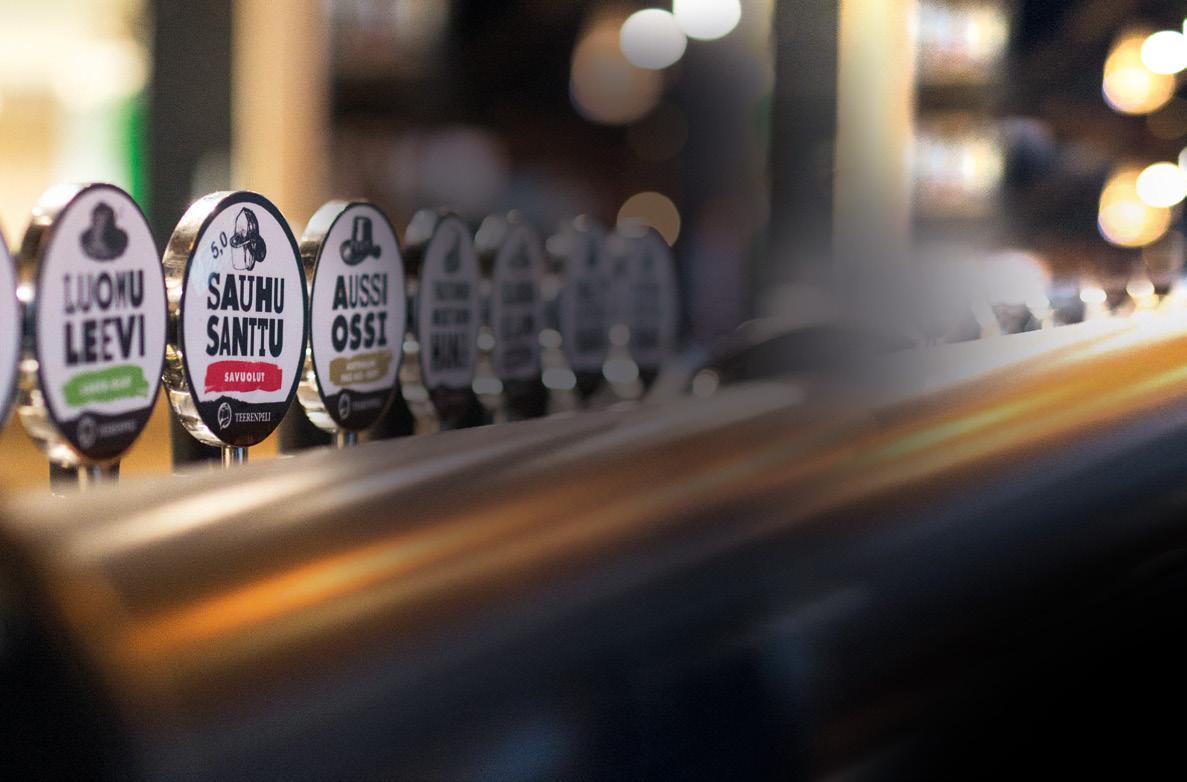
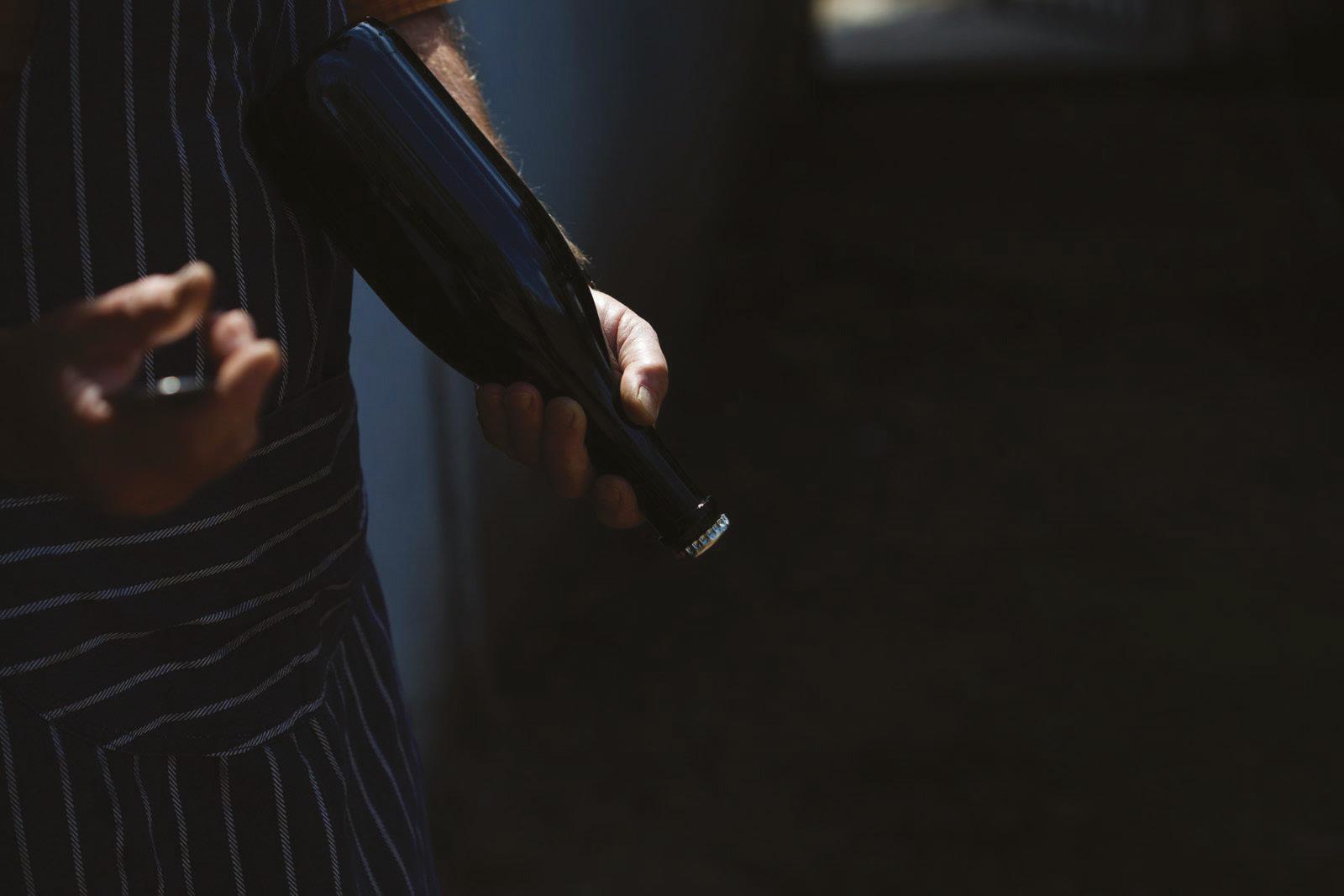
BEERS AND WHISKIES FROM OWN BREWERY AND DISTILLERY
• KITCHEN OPEN TILL CLOSING TIME
Korkeasaari Zoo is open all year round Daily from 10 am. During summer several restaurants, cafés, kiosks and picnic areas are spread around the island. During spring, fall and winter, at least one restaurant is open.
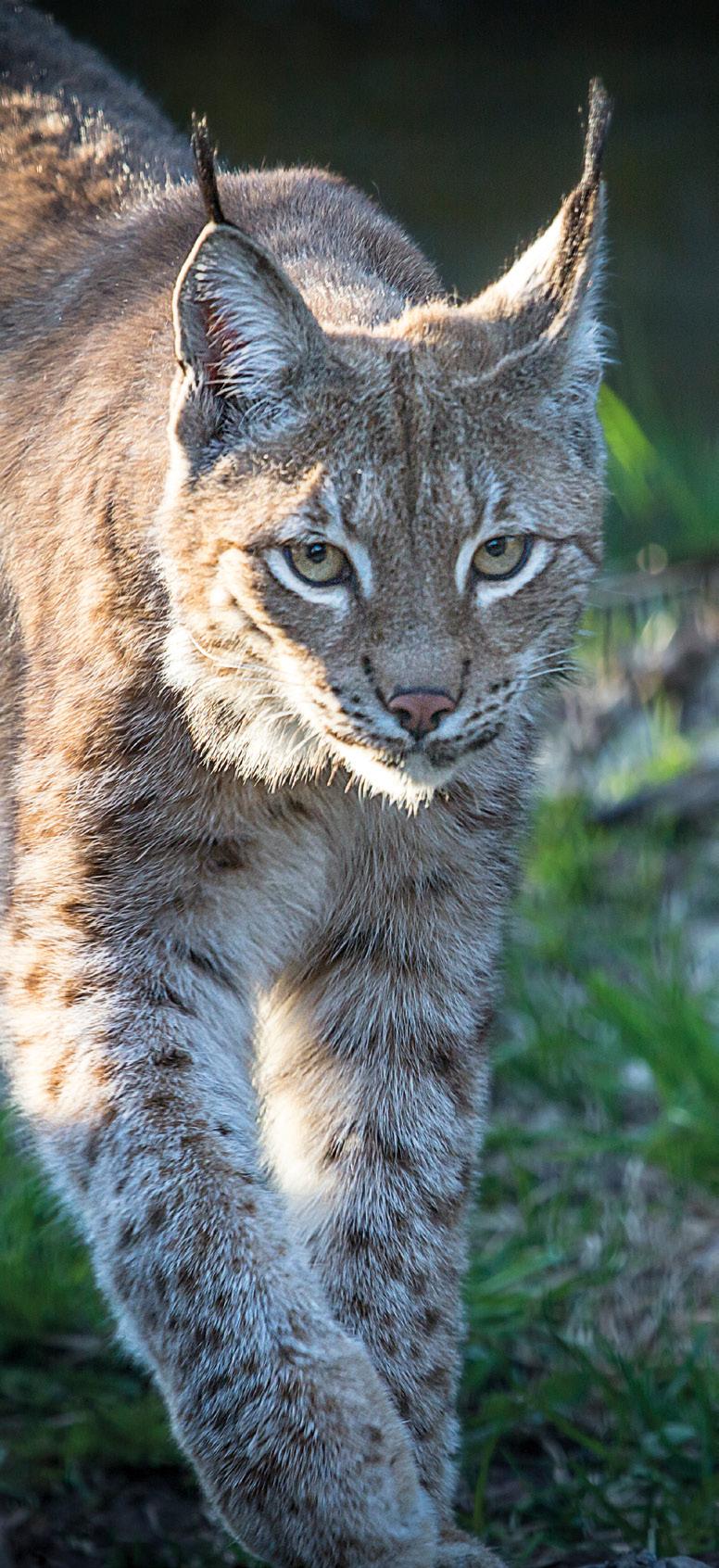
Near the city but far from the rush Korkeasaari Zoo is uniquely located on an island in the Baltic Sea. It’s just outside the city, you can literally see the Helsinki Cathedral from the zoo. It takes only 20 minutes to get here by local bus (no 16) from the Railway Station of by ferry from the Market Square. Meet animals from the Himalayas, Siberia, Mongolia, Finland and the Asian rainforest – more than 150 species in total – while enjoying the silence and peace of the Finnish nature surrounding you.
Animals who are not afraid of cold It is not a coincidence that the snow leopard’s only bare spot is the tip of its nose or that the snowy owl is white and fluffy. Animals have their ways to adapt to cold climates. At Korkeasaari Zoo we want our large animals to enjoy outdoor life throughout the year. Therefore, instead of seeing a giraffe or a hippo, you will see a wolverine, a forest reindeer, an Amur tiger and a Bactrian camel – all species adapted to extreme winter. On a windy day, follow suit from the animals and dress warmly. If it gets too chilly, take refuge in the warm tropical houses.
To visit Korkeasaari Zoo is to act for nature Our mission is to conserve biodiversity. We want our visitors to value the importance of biodiversity and aim to motivate behavior change for conservation. In cooperation with other modern zoos, we breed endangered species to maintain a healthy and viable zoo population. Zoo populations have already saved various species from extinction. In order to support our mission in protecting wild animals and their natural habitats, we donate annually to various field conservation projects. Bring your coins and donate to the project of your choice. By visiting Korkeasaari Zoo, you support our work as defenders of biodiversity and endangered species.
From zoos to the wild Do you know what European bison, bearded vulture, European forest reindeer and Przewalski´s wild horse have in common? All these species have been lost from the wild locally or globally, and brought back from extinction with the help of zoos, Korkeasaari Zoo among them.




